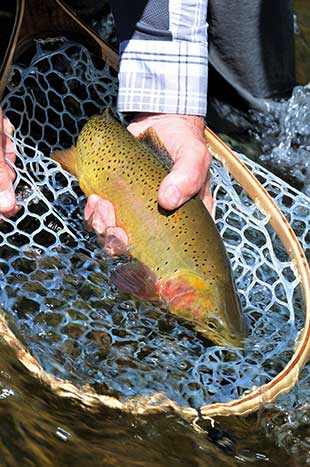Nonnative Trout: Where We Went Wrong

Native Southern Appalachian Brook Trout (Great Smoky Mountain Natuonal Park)
While once viewed, and rightly so, as the best steward of the resource in the sporting community, can trout fishers truly make that claim today? Is any group of sportsmen more accepting of nonnative species than us? More reliant on artificial propagation and husbandry? As willing to embrace hybrids and other genetic mutations? Has any group of sportsmen lost more native fauna?
Prior to the late 1800s, most of the trout, and I use the term figuratively, caught in America belonged where they were found. The east was home to brook trout, the Rocky Mountains to cutthroat, and the west coast to rainbow trout. There were Arctic charr in New England, Gila and Apache trout in the southwest, and golden trout in California. And Arctic grayling could be found in the Northern Rockies and Michigan.
Today we have rainbows east of the divide, brookies west of the Great Lakes, browns of European ancestry from coast to coast, all of which have been introduced on top of native trout. Gila and Apache trout are hanging by a thread, pushed out by exotic rainbows and browns. Arctic charr are gone from New Hampshire and Vermont and extant in just eleven native waters in Maine, driven out by alien lake trout and landlocked salmon. And browns have pushed grayling out of Michigan, and along with rainbows, greatly reduced them in the Rockies.
To be fair, we trout fishers did not start the nonnative train down the track, the federal government did, specifically, the US Fish Commission. And not long after the feds started playing god in early 1870s, state fish and game managers enthusiastically jumped into the fray, and with both feet. But to be clear, our exploitation of the resource was at least partly to blame, and some would argue, very much so.

Yellowstone Cutthroat (Wood River, WY)
Rainbow trout were first introduced outside their native range in 1875. Brown trout showed up on US soil, or more appropriately, water, in 1883. According to US Fish and Wildlife, “As early as 1850 the range of the brook trout started to extend west through introductions.” Cutthroat, golden trout, Arctic charr, and grayling were moved around as well, but to a much lesser degree than bows, brookies, and browns.
In the 1930s through 1950s, chinook, chum, coho, and sockeye salmon, all Pacific species, were stocked into waters in Maine – thankfully they didn’t take. Starting in 1889, brook trout were introduced to Yellowstone National Park, the nation’s flagship public land and one of the most intact ecosystems in America. Brown trout, lake trout, and rainbow trout followed. Basically, we threw nonnative fish around like rose petals at a wedding.
Once the nonnative movement took hold and gained the acceptance and support of the trout fishing masses, state fisheries managers ramped it up and upped the ante. They engineered pigment-deprived “palomino” trout, hybrid splake and tiger trout, and fast-growing nad-zapped triploids, all to satisfy the odd appetite for unnatural fish from within the trout angling community.
While we trout fishers didn’t start the nonnative movement, we didn’t try to stop it either. And in many ways we have perpetuated it by supporting and even encouraging what amounts to government-sponsored bucket biology. Like many modern state fisheries managers, today’s trout angler has become enamored with nonnative species, and other things that don’t belong there.
While we fly fishers are admittedly the ones who started the trout conservation movement, it was in trouble right out of the gate. Begun on the banks of the fabled AuSable River in Michigan, a nonnative brown trout fishery that existed at the expense of locally extirpated Arctic grayling, the focus was on wild versus stocked fish, not native versus nonnative fish.
You could call what happened to the nation’s native trout “the perfect storm.” A lot of things went wrong at once. Angler exploitation degraded our fishing. Habitat degradation did as well. And anglers wanted more than they were getting, and stocking was seen as an alternative to what would have been unpopular at the time reductions in creel limits and tackle restrictions.
As anglers began to get used to stocked fish, shifting to nonnative fish was not that big of a leap. In some cases, the nonnatives did better than the natives. In other cases, they grew bigger, or faster. Some nonnative trout fought better than the natives. In many cases, anglers did not know the difference, or understand the consequences. And why should they, it was after all the “experts” who were moving the nonnatives around.
As they say, when it comes to nonnative trout, the horse is out of the barn and cannot be put back. Nonnative trout are here to stay. But there appears to be a pro-native movement taking hold that gives me hope we can still hold on to some of what Mother Nature gifted us: Wild native trout. We have the knowledge and technology to do it. The question is do we have the will? The stamina? The appreciation for wild native things?
Hopefully we trout fly fishers can regain our position as the most ecologically enlightened sportsmen. We started fish conservation; we can do it again. We have lessened our footprint by embracing low-impact tackle and promoting catch-and-release. We now shun hero shots in favor of #keepemwet. No one does more habitat work. And few sporting groups have a stronger media, outreach, and volunteer ethic. Let’s put some of that to work saving what is left of our wild native trout and regaining some of what we’ve lost.











